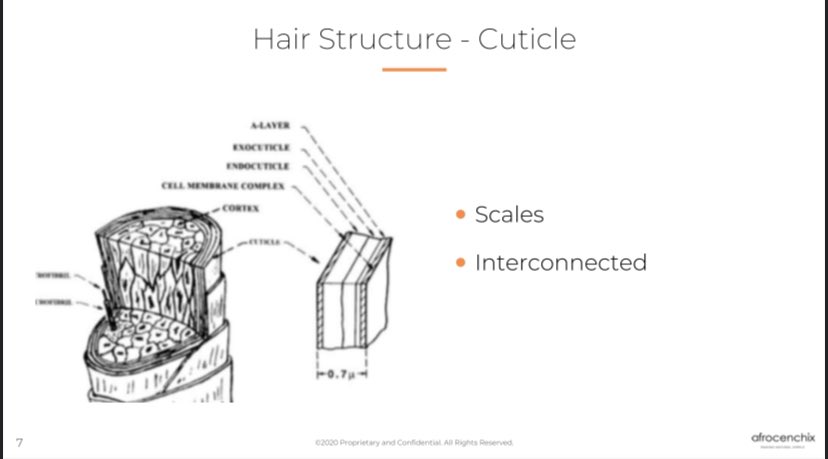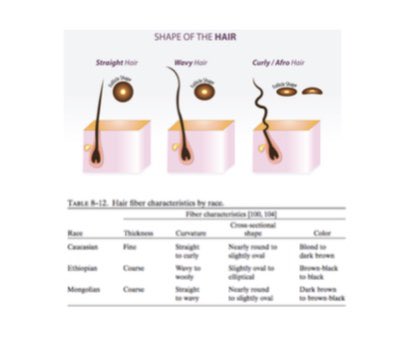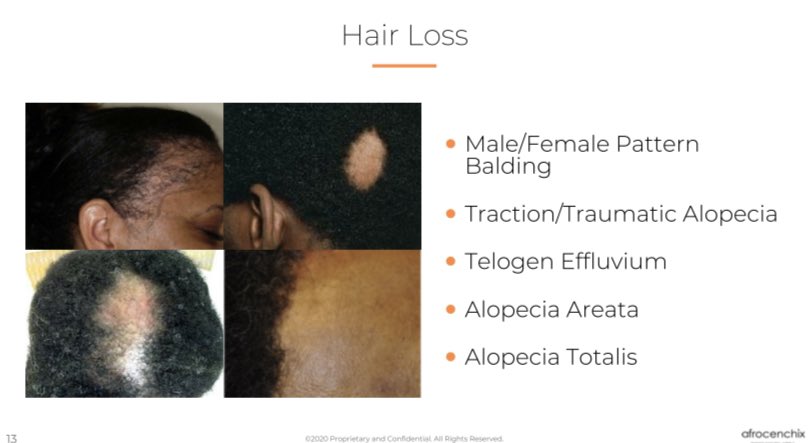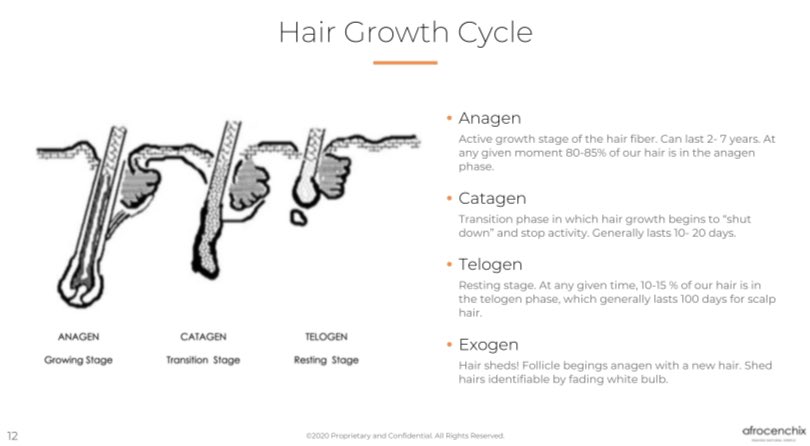Been asked to do a haircare SCAMS thread on behalf of @Afrocenchix as inspired by this great one on skincare.
Let’s go. https://twitter.com/angelamavalla/status/1365273876096311298">https://twitter.com/angelamav...
Let’s go. https://twitter.com/angelamavalla/status/1365273876096311298">https://twitter.com/angelamav...
First off, porosity.
Hair is not porous. It doesn’t have pores. It doesn’t even have a cuticle that opens and shuts (more on this later)...
Hair is made up of bundles of keratin protein, encased in a keratin cuticle or many layers. Kinda like an armadillo shell. No pores...
Hair is not porous. It doesn’t have pores. It doesn’t even have a cuticle that opens and shuts (more on this later)...
Hair is made up of bundles of keratin protein, encased in a keratin cuticle or many layers. Kinda like an armadillo shell. No pores...
Before team “knowing my porosity changed my life” come for me... I get what you guys mean.
When we discuss porosity in hair, we mean to measure how easily water is taken up and lost. So technically gaps in a structure can be classed as pores...
When we discuss porosity in hair, we mean to measure how easily water is taken up and lost. So technically gaps in a structure can be classed as pores...
ALL hair will have small gaps in the cuticle due to everyday damage that chips away at the cuticle.
When people speak about & #39;high porosity& #39; hair, they refer to hair that is more damaged than & #39;low porosity& #39; hair. Hair that is ‘porous’ is more susceptible to swelling.
When people speak about & #39;high porosity& #39; hair, they refer to hair that is more damaged than & #39;low porosity& #39; hair. Hair that is ‘porous’ is more susceptible to swelling.
And this isn’t a good thing. If your hair swells more and easily absorbs moisture, then you could be prone to hygral fatigue which will weaken, and eventually break, your hair.
So if your hair is “low porosity” you don’t need to “open the cuticle.” Just enjoy having hair that isn’t very damaged... well in places... it’s probably more damaged in some parts than others...
Get this... unless you’ve drastically cut your hair in the last year, it will be damaged at the ends. The ends of your hair are the oldest and most fragile part.
Hair grows about 6 inches a year, so if you haven’t cut your hair for 2 years, then the ends are up to 2 years old
Hair grows about 6 inches a year, so if you haven’t cut your hair for 2 years, then the ends are up to 2 years old
That’s two years of damage. Even if you avoid blow dryers, straighteners, dodgy tools and harsh chemicals like bleach, your hair will still be damaged by sunlight exposure to UV rays, pollutants in the hair and friction from styling.
Your ends are always more “porous”
Your ends are always more “porous”
You may also find that the back of your hair is more damaged as it rubs against clothing or your pillow (wear a bonnet guys!)
So your hair will have different levels of damage, or porosity, in different places.
One of many reasons why the “sink or float” test is junk science
So your hair will have different levels of damage, or porosity, in different places.
One of many reasons why the “sink or float” test is junk science
Enough on porosity. Onto hair typing.
4c, 3a, 2b or not 2b. None of these things have any scientific backing. In fact, the hair typing system was made up by a guy on Oprah. Andre Walker created his hair typing system in order to determine how “tough” it was to straighten hair
4c, 3a, 2b or not 2b. None of these things have any scientific backing. In fact, the hair typing system was made up by a guy on Oprah. Andre Walker created his hair typing system in order to determine how “tough” it was to straighten hair
So is there truth in hair typing? A little, I’ll get to that.
First let’s talk about the types. We’ve spoken to thousands of @Afrocenchix customers who wonder what’s wrong with their hair as it “4c in one place and 3b in another.”
It’s not. Your hair is fine. Typing is a scam.
First let’s talk about the types. We’ve spoken to thousands of @Afrocenchix customers who wonder what’s wrong with their hair as it “4c in one place and 3b in another.”
It’s not. Your hair is fine. Typing is a scam.
Okay so there are some loosely recognised types. At the Institute of Trichologists we learn about 3 types used by anthropologists and biologists:
Negroid, Caucasoid & Mongoloid (I know)
Negroid, Caucasoid & Mongoloid (I know)
A more recent classification system was proposed in a journal a few years back. This was based on a study of the degree to which hair curls and the way that these curl patterns are distributed worldwide.
In any case, when searching for products there are factors that matter. Porosity and hair type are distractions, marketing ploys created to make you think that you are the problem rather than ineffective products. “Low porosity range didn’t work? Try high porosity!”
Yeah. Sure.
Yeah. Sure.
So what does matter?
The diameter of your hairs and density of the hair follicles on your head will determine how thick or full your hair appears. Someone can have fine individual hairs, but a lot of them and look like they have thick hair, but it will be fragile (it’s me)
The diameter of your hairs and density of the hair follicles on your head will determine how thick or full your hair appears. Someone can have fine individual hairs, but a lot of them and look like they have thick hair, but it will be fragile (it’s me)
It’s also good to figure out how to best hydrate your hair and keep it moisturised (technically we mean keep the hydrogen bonds intact, seal the moisture in and keep the hair conditioned and lubricated to avoid breakage.)
Oils do not moisturise. Water alone isn’t ideal either.
Oils do not moisturise. Water alone isn’t ideal either.
Really you want humectants like aloe vera or glycerine, which draw moisture into the hair. Ideally in water based products, so the water comes from the product & not the air (as this can lead to frizz on humid days and dryness on less humid days)
High up on the ingredients list!
High up on the ingredients list!
Most of haircare is ensuring:
- your scalp is clean & healthy
- good diet for optimum growth
- reducing the damage to the hair as it grows.
Hair is dead. Treat it like silk.
Taking hair vitamins alone won’t fix your problems.
Magic hair growth oils/serums = scam.
- your scalp is clean & healthy
- good diet for optimum growth
- reducing the damage to the hair as it grows.
Hair is dead. Treat it like silk.
Taking hair vitamins alone won’t fix your problems.
Magic hair growth oils/serums = scam.
I get upset when I see those suffering with alopecia be sold lotions and potions that:
A) they don’t need as the hair was growing back
Or
B) won’t work because their follicles are gone
See a doctor or trichologist if you have major hair loss or any severe itchiness or scarring.
A) they don’t need as the hair was growing back
Or
B) won’t work because their follicles are gone
See a doctor or trichologist if you have major hair loss or any severe itchiness or scarring.
Afro hair is big money. The market is worth billions and growing fast, so of course there are many unethical businesses out here. Large and small.
In the 12 years since @JoyMateSpeaks & I started @Afrocenchix and the 8 years since I studied Trichology, we’ve seen it all.
In the 12 years since @JoyMateSpeaks & I started @Afrocenchix and the 8 years since I studied Trichology, we’ve seen it all.
Be careful who you trust with your scalp. Do your research. Are they using big campaigns to distract you from disappointing results? Are they shady about operating in a safe & legal fashion? Are they making claims that are too good to be true? Be wary... I’ve heard horror stories
Remember that 6 inches of hair growth a year is normal, and it’s easiest to retain length when your hair is short. Going from bald to 6 inches in a year does not make someone an expert or prove their product is a miracle. Nor does long hair alone...
Genetics vary. If your anagen phase lasts 7 years then you can grow 42 inches of hair. If it lasts 2 years then you can grow 12 inches of hair. Even after 7 years, the hair will just stop growing around 12 inches of length and get ready to drop out (still past shoulder length)
No idea why the thread ended at this point! Here’s the rest: https://twitter.com/RaeCorson/status/1366480438924042242">https://twitter.com/RaeCorson...

 Read on Twitter
Read on Twitter






